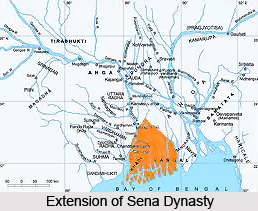 Downfall of Sena dynasty was destined under the rule of weak rulers of this dynasty. This dynasty started declining during the rule of Lakshmanasena. During his reign fatalism, superstition eroded the patriotic zeal of the people. He never infused the people with a spirit of determined resistance. Lakshmanasena never reformed his army according to that of Turks. Astrology was more important than military science. He was succeeded by his son Visvarupasena who did rule for few years. Kesavasena is the last known ruler of this dynasty.
Downfall of Sena dynasty was destined under the rule of weak rulers of this dynasty. This dynasty started declining during the rule of Lakshmanasena. During his reign fatalism, superstition eroded the patriotic zeal of the people. He never infused the people with a spirit of determined resistance. Lakshmanasena never reformed his army according to that of Turks. Astrology was more important than military science. He was succeeded by his son Visvarupasena who did rule for few years. Kesavasena is the last known ruler of this dynasty.
The process of disintegration can be attributed to various factors. Lakshmanasena or his successors were not competent enough to check the disintegration, which crept up in the strong foundation of the Sena kingdom. The result was completely chaotic. Towards the end of Lakshmana Sena`s rule Khadi Mandala and twenty-four Parganas were captured by Dommanapala. Tippera was under the supremacy of Sena dynasty but became independent in the thirteenth century. Even the east of Meghna region was ruled under the Deva family. Vikramapura, capital city of Senas were captured by King Danujamardana Dasharathadeva, who belonged to the same family. Muslim attack was also one of the major reasons for the decline of this dynasty. When the Sena kingdom was completely disrupted, the Turkish invasion led by Bakhtiyar Khilji blow down the strong foundation of the Sena kings in Bengal. During the closing of the 12th century all the Hindu kings in Northern India gradually submitted to the Turkish invasion led by Muhammed Ghori. They had conquered Northern Bengal from where they had pressurized the Senas of the Eastern Bengal. Sultan Ghiyas- ud - din and Malik Saif - ud - din weakened the power of the Senas leading to their collapse ultimately.
This article is a stub. You can enrich by adding more information to it. Send your Write Up to content@indianetzone.com



















